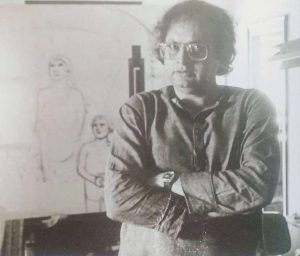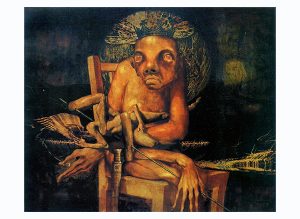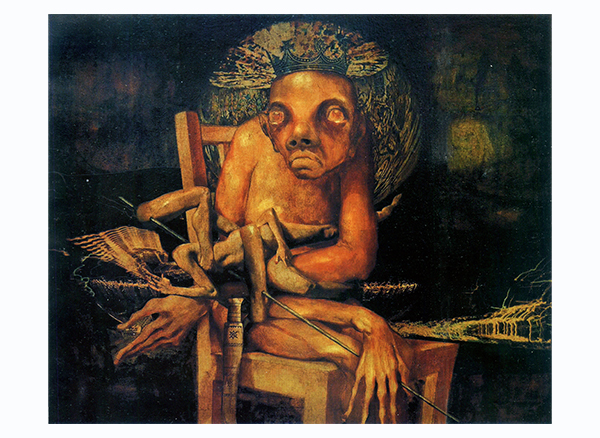Abhishek Dixit
Through his work, Bikash uses metaphorical methods to define realities in the subtlest of ways. His whole imagination is taken into account by evaluating one of the most symbolic works.

Known as one of India’s best-known surreal artists, Bikash Bhattacharjee’s works meticulously highlighted the daily lives of Bengali residents. He exhibited a great deal of imagination and gave new insight into the world through his work. Born in Kolkata in 1940, he graduated in 1963 from the Indian College of Arts and Draftsmanship, Kolkata. A National Award and a Padma Shri were both awarded to him in recognition of his valuable contribution to art. A famous surrealistic portrayal of political turmoil in Kolkata is one of Bikash’s trademarks. Painting remained his passion, despite the loss of his father at such a young age. In addition to being supported by his mother and a friend for life in Katayun Saklat (his classmate), Bikash was sharpened by teachers like Arun Basu. By describing middle-class Bengal families and their politics in the most immaculate ways, he demonstrated his understanding of reality.
‘Untitled’ by Bikash Bhattacharjee exhibits distortions where both the subject and the setting seem unrecognizable. This work conveys a feeling of loneliness and isolation, as the subject appears alone and separated from reality. It seems the artist created a unique world for the outcasts in this world, which is different from the utopia we’re all looking for. A crown is placed on the head of an unknown figure composed centrally. The authoritarian figure is definitely trying to control. The figure appears to have an aura of sorts in the plastic form, which is revealed upon closer examination. Light is only on the figure, so we can closely examine the posture of the body in this dimly-lit space. The painting has excellent depth thanks to the high and low contrast lighting. It appears to be a female figure or a fairy (because of the wings) sitting on a chair holding an unidentified object in its hand. This work is composed in such a way that it creates tension; the artist was certainly convinced enough to put it that way. Almost no surrealists have been produced in India, and these works indicate the ability of artists who have refused realism since independence.

Courtesy- The Arts Trust
The visual structure and symbols used in this work may be difficult to understand at first, but a detailed analysis will reveal the subtleties of its visual structure. It is interesting to note the difference in proportion between the female figure he is holding and the figure on the chair. There is no doubt that their world is different and unique. We are drawn to the central figure only due to the lack of light in the background. Viewers encountered a claustrophobic experience as the work deliberately missed profundity and brightness. This work holds a mystery within the realm of this painting’s settings. The figurative aspect of the work defines that the central figure is bent forward and holding the female figure in his left hand whereas his right hand is holding a stick to which the female figure is also bonded.
A pyramid is easily recognizable in terms of composition. The focus is more on the subject and the background is dim. The important element here is that the artist has beautifully divided the painting into three parts using vertical and horizontal lines. There is no emotion in the big round eyes of the central character as if it is quite normal for him to be in this situation. His face is flat and he seems to be in a relaxed posture. His fingers are long and thin, in his left hand he holds a cigarette through which the smoke is easily discernible. The intricacy of this painting is what really makes it perfect; It defies all norms of analysis of the work from the point of view of the subject and invites us to look at it objectively or plastically in order to derive meaning.
The dominant use of yellow, black and red defines the subtlety of Bikash’s mind. The colors merge with each other, and it is also difficult to identify elements within the painting. For example, the crown on top of the figure’s head is not easy to identify. There is no rhythmic pattern in the work; However, the expressive means reflect the psychological understanding of Bikash as he looked at this world. There is a feeling of detachment from the real world, and the viewer becomes uncomfortable when he looks into the eyes of the figure. The use of colors in this painting by Bikash creates a harmonious relationship with the background as it juxtaposes the realms of imagination and reality. Space is not alive and is covered in darkness. The orange is highly visible and the saturation makes it more likely for the character to reach the viewer’s eye. The lines are strongly drawn and play an important role. Colors are distorted, and warm tones are used. I am amazed by the distorted shapes and lines that are used here to create a feeling of being trapped and caged, however, the emptiness and isolation is something that is profoundly inherited in this work. The unity of the elements can be seen and understood in the form of many reduced figures and structures.
Bikash used many motifs in his work throughout his artistic journey, and he was confident enough to use his elements effectively in the most thoughtful ways. Bikash’s work also raises questions about the material world but within the realm of fantasy.





